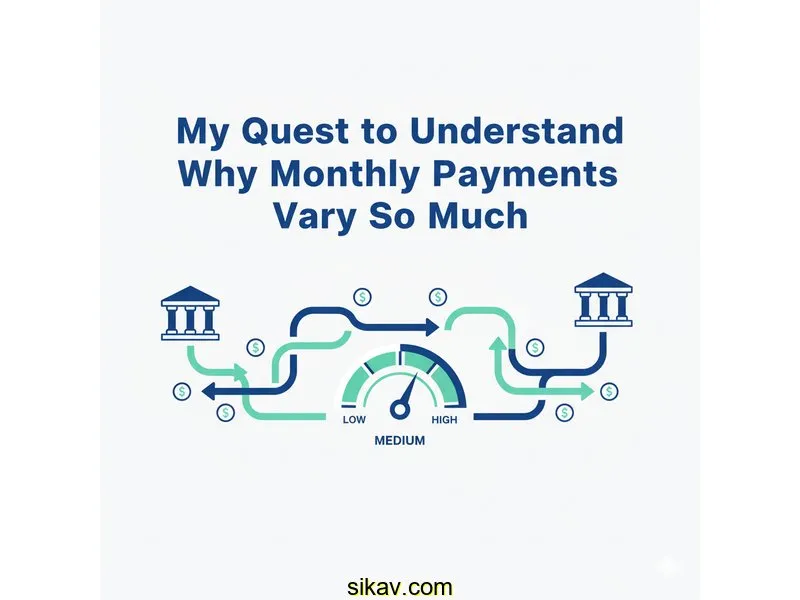
Auto Loan Calculator
Calculate payments over the life of your Loan
Home Blog Privacy Terms About Contact
Calculate payments over the life of your Loan
Home Blog Privacy Terms About ContactPublished on October 14, 2025

My journey into the world of loan math didn't start with a big financial goal. It started with a simple, nagging question that popped up during a casual chat with a friend. We were talking about car repairs, and he mentioned his monthly payment for a personal loan he’d taken out. It seemed surprisingly low for the amount he borrowed.
When I mentioned that, he shrugged and said, "Yeah, I just stretched it out as long as possible to keep the payments down." That single sentence stuck with me. How could two people borrow a similar amount of money but have drastically different payments? More importantly, was a lower payment always the better deal?
I went home that evening with a fire of curiosity lit under me. I pulled up a generic online loan calculator, determined to understand the mechanics behind that conversation. My goal wasn't to make a decision, but simply to decode the numbers. I wanted to see, with my own eyes, how changing one little number—the loan term—could ripple through the entire calculation.
My first few attempts were clumsy. I plugged in some numbers, saw the monthly payment change, but I didn't truly grasp the "why." The calculator was a black box, spitting out answers I couldn't explain. I knew there was a story hiding in those numbers, a story about time, interest, and cost, and I was determined to learn how to read it. This is about understanding how calculations work, not financial advice. It's the story of how I taught myself to see beyond the monthly payment.
My initial confusion began when I decided to run a specific test case. I imagined a hypothetical loan for a significant home project, let's say for $13,850. I found a calculator and plugged in the numbers, setting an interest rate of 7.2%. The first field that caught my eye was "Loan Term," so I decided to compare a 4-year term against a 6-year term.
First, I entered 48 months (4 years). The calculator returned a monthly payment of about $336.56. Okay, that was my baseline. My brain immediately categorized that as "the higher payment option."
Then, I changed only one thing: the loan term. I switched it to 72 months (6 years). The calculator updated instantly, showing a new monthly payment of around $238.45. The difference was stark—almost $100 less per month! My initial, completely wrong thought was, "Wow, this is obviously the better choice. Who wouldn't want to pay $100 less each month?" I was focusing entirely on that single output field, the monthly payment, because it felt like the most tangible, real-world number.
But that's where the contradiction started to creep in. I had this nagging feeling that it couldn't be that simple. Why would anyone choose the higher payment if the lower one was available? It felt like a magic trick, and I didn't understand the secret. My mistake was fundamental: I was comparing monthly payments but completely ignoring the loan terms and their impact on the total cost. I was looking at a single puzzle piece instead of the entire picture. The calculator was giving me all the information, but I was only reading one line of it, leading me to a flawed conclusion.
I spent a good half-hour just toggling the term back and forth, watching the monthly payment jump up and down. I was stuck in a loop, impressed by the lower payment but suspicious of the simplicity. I knew I was missing a key part of the calculation, a piece of the puzzle that would explain this apparent contradiction. That's when I started looking closer at the other, less prominent fields in the calculator's results.

My breakthrough came not from a complex formula, but from simply letting my eyes wander down the calculator's results page. Below the big, bold "Monthly Payment" number, there was a smaller, less exciting line item: "Total Interest Paid." I had been completely ignoring it, but in my frustration, I finally decided to pay attention to it.
I ran my experiment again. For the 48-month loan at $336.56 per month, the "Total Interest Paid" was $2,304.88. Then, I switched to the 72-month loan. The monthly payment dropped to that attractive $238.45, but the "Total Interest Paid" shot up to $3,318.40. That was it. That was the missing piece.
Seeing those two numbers side-by-side was a genuine "aha" moment. The lower monthly payment came at a cost of over $1,000 extra in interest over the life of the loan! The magic trick was revealed: there was no magic, just a mathematical trade-off. I wasn't getting a "cheaper" loan; I was just paying for the convenience of a lower monthly bill with more interest over a longer period. It was the first time I understood that monthly payment and total cost tell two very different stories.
My next step was to understand why more time meant more interest. I learned that interest is calculated on the remaining balance of the loan each month. With a longer-term loan, the principal balance goes down more slowly because each smaller monthly payment is dedicating a larger percentage to interest, especially in the early years.
More months literally means more opportunities for interest to be calculated on a higher remaining balance. A shorter term forces you to pay down the principal faster, reducing the balance that interest is charged on and, therefore, reducing the total interest paid over time.
I started to see the relationship as a seesaw. On one side, you have the monthly payment. On the other, you have the total interest cost. When you push the monthly payment down by extending the term, the total interest cost goes up. When you increase the monthly payment by shortening the term, the total interest cost goes down.
The calculator became my sandbox for exploring this seesaw effect. It wasn't about finding a "right" answer, but about understanding the balance and the trade-offs involved in the calculation itself. The tool was no longer a black box; it was a visual aid for a mathematical concept.
To be sure I really got it, I ran more scenarios. What about a 5-year (60-month) term? I plugged it into the calculator for my $13,850 loan at 7.2%. The result was a monthly payment of about $278.03 and total interest of $2,831.80. It fit perfectly in the middle, just as I expected. The payment was lower than the 4-year term but higher than the 6-year one. The total interest was more than the 4-year term but less than the 6-year one. Seeing that consistent pattern solidified my understanding. The numbers weren't magic; they were logical and predictable once I knew what to look for.
This journey, which started with a simple question about a friend's loan, taught me so much about how loan calculations actually work. It wasn't about making a financial choice, but about gaining literacy in the language of numbers. Here are some of the key lessons I took away about the calculations themselves:
I learned the best way is to keep all other variables the same (loan amount and interest rate) and only change the term. Create a simple table or just jot down the monthly payment and the total interest paid for each term you're considering (e.g., 36, 48, 60 months). This side-by-side comparison makes the mathematical trade-off very clear.
It's because interest is calculated on the outstanding balance over time. With a longer term, your principal balance decreases more slowly. This means there is a higher balance for a longer period, giving interest more time and a larger base to accumulate on over the full life of the loan.
From a pure calculation standpoint, if the only variable you change is extending the loan term to get a lower payment, the answer is yes. A longer term will always result in more total interest paid, assuming the interest rate is the same. The calculator demonstrates this mathematical certainty.
Every monthly payment is made up of two parts: principal (the money you borrowed) and interest (the cost of borrowing). In the beginning of a loan, a larger portion of your payment goes to interest. As you pay down the balance over months and years, more and more of your payment shifts toward paying down the principal. An amortization schedule calculator can show you this breakdown for every single payment.
Looking back, my biggest takeaway wasn't about what makes a "good" or "bad" loan. It was about empowerment. Before, a loan calculator was a mysterious box that gave me answers I didn't understand. Now, it's a tool for exploration and learning. I know which levers to pull to see how the outcomes change, and I know which output fields tell the most important parts of the story.
The core lesson for me was that the monthly payment and the total cost are two sides of the same coin, intrinsically linked by the element of time. Understanding that relationship is, I believe, a fundamental piece of financial literacy. It’s not about judging my friend's choice but about finally understanding the math behind it.
I hope sharing my learning process encourages you to play with the numbers, too. Use the online tools not just for answers, but for understanding. The confidence that comes from knowing how the calculations work is a reward in itself. My name is Alex, and I’m just a regular person figuring this stuff out one calculation at a time.
This article is about understanding calculations and using tools. For financial decisions, always consult a qualified financial professional.
Disclaimer: This article documents my personal journey learning about loan calculations and how to use financial calculators. This is educational content about understanding math and using tools—not financial advice. Actual loan terms, rates, and costs vary based on individual circumstances, creditworthiness, and lender policies. Calculator results are estimates for educational purposes. Always verify calculations with your lender and consult a qualified financial advisor before making any financial decisions.
